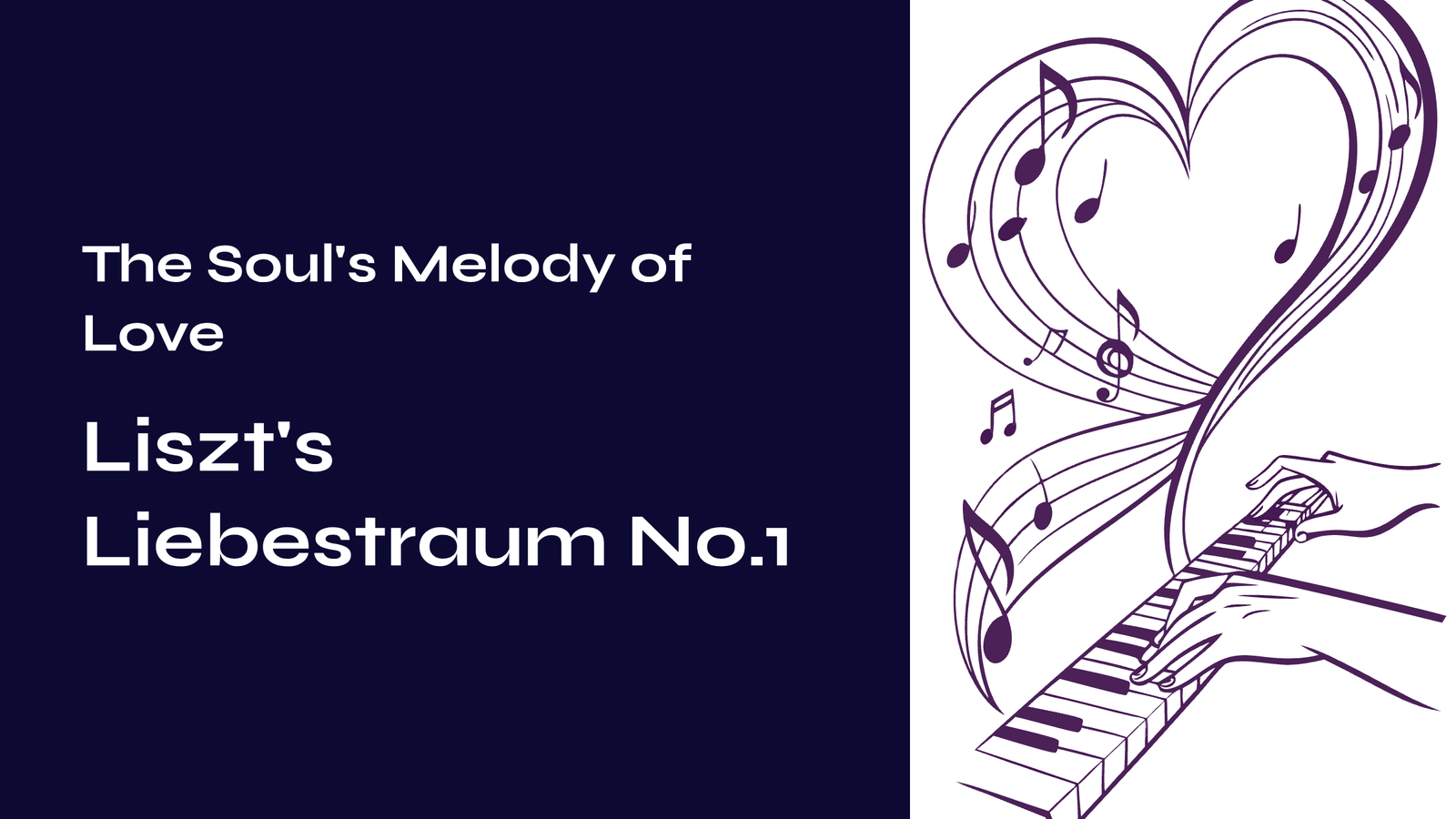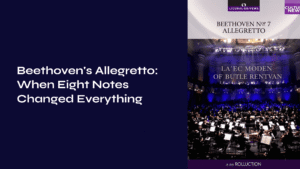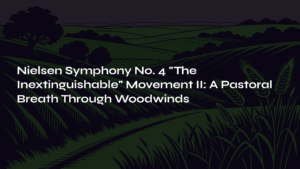Table of Contents
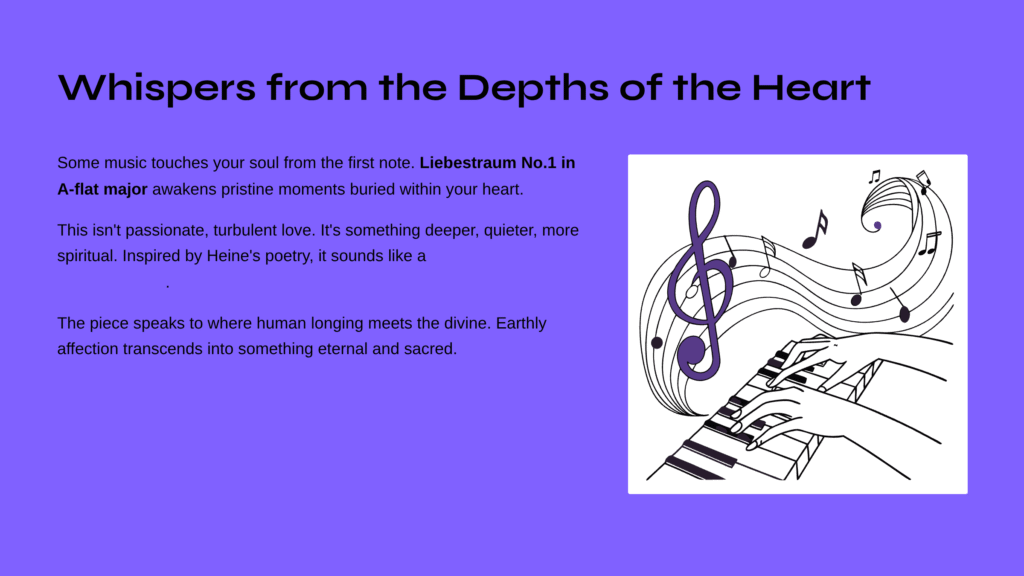
Whispers from the Depths of the Heart
Some music touches the deepest corners of your soul from the very first note. Liszt’s Liebestraum No.1 in A-flat major is precisely such a piece. The melody flowing from the piano keys seems to awaken the most pristine moments buried within your heart, as if someone were gently calling forth memories you thought were lost forever.
When I first heard this piece, I realized how multifaceted the emotion we call love truly is. This isn’t the passionate, turbulent love we commonly imagine, but something deeper, quieter, more spiritual. This music, inspired by Heine’s poetry, sounds less like a simple love song and more like a prayer filled with the soul’s yearning.
The piece speaks to something universal yet intimate—that place where human longing meets the divine, where earthly affection transcends into something eternal and sacred.
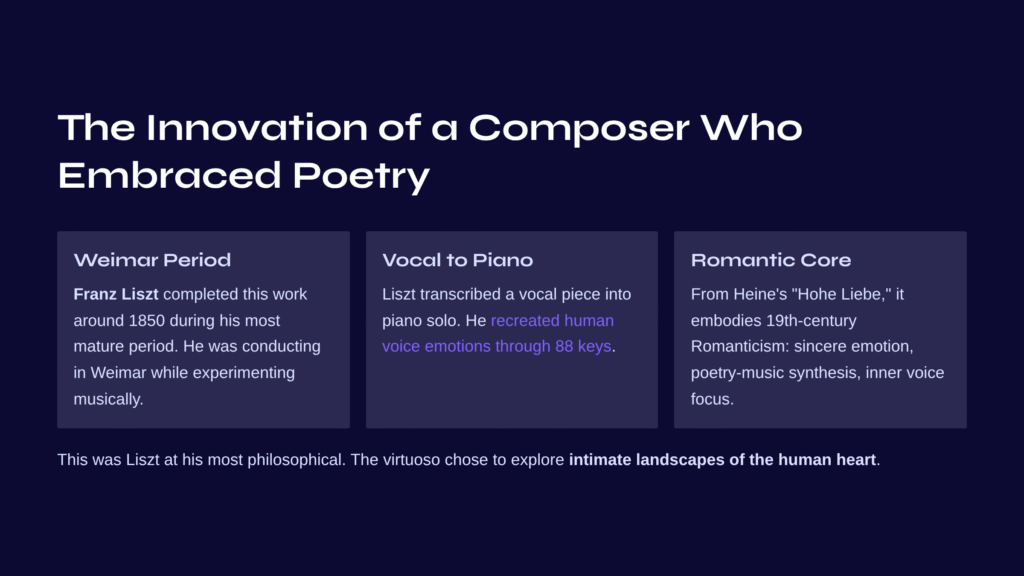
The Innovation of a Composer Who Embraced Poetry
Franz Liszt completed this work around 1850, during the most mature period of his life. At the time, he was conducting in Weimar while immersing himself in musical experimentation. In transcribing what was originally a vocal piece into a piano solo, Liszt accomplished the remarkable feat of recreating the emotions conveyed by the human voice through 88 keys.
Originating from Heine’s poem “Hohe Liebe” (Sublime Love), this music embodies the core characteristics of 19th-century Romantic music: sincere expression of personal emotion, perfect synthesis of poetry and music, and a focus on inner voice rather than mere technical display. Liszt’s characteristic harmonic adventurousness shines through here as well, but with unprecedented restraint and elegance.
This was Liszt at his most philosophical—the virtuoso who could dazzle audiences with technical brilliance choosing instead to explore the intimate landscapes of the human heart. The result is music that speaks directly to the listener’s emotional core, bypassing intellectual analysis to achieve something more immediate and profound.
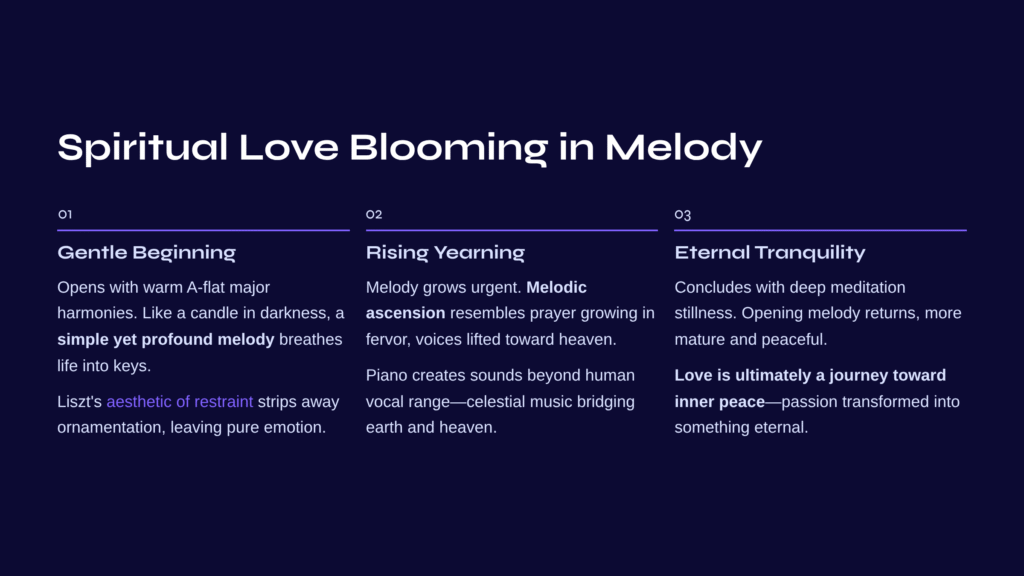
Spiritual Love Blooming in Melody
Gentle Beginning, Deepening Confession
The piece opens with the warm, soft harmonies of A-flat major. Like a single candle burning quietly in darkness, a simple yet profound melody breathes life into the piano keys. The left hand’s accompaniment resembles the heart’s rhythm, while the right hand’s melody sounds like the soul’s earnest calling.
What strikes me most about this opening is Lisst’s aesthetic of restraint. The composer so famous for dazzling virtuosity here strips away all ornamentation, leaving only pure emotion. Each note breathes, each harmony carries meaning, and nothing is superfluous.
The opening phrases unfold with the natural rhythm of spoken confession—intimate, unhurried, as if the music were sharing its most precious secrets. There’s a vulnerability here that draws the listener into a space of sacred intimacy.
Waves of Emotion, Rising Yearning
As the piece progresses, the melody grows increasingly urgent. The melodic ascension in the middle section resembles a prayer growing in fervor, voices lifted toward heaven. Liszt employs his unique harmonic language here—unexpected chord progressions, delicate resolutions of dissonance that guide us deeper into the emotional landscape.
Particularly noteworthy are the moments when the melody spans octaves. Here, the piano seems to create sounds beyond the human vocal range—celestial music that bridges earth and heaven. The deep resonance from the lower registers and the crystalline clarity of the upper notes form a perfect unity.
The music seems to breathe with human lungs while reaching for something beyond human limitation. It’s in these moments that Liszt’s genius becomes most apparent—his ability to make the piano sing not just with human voice, but with something more transcendent.
Finding Eternity in Tranquility
The piece’s final section concludes with the stillness of deep meditation. The opening melody returns, but now more mature and peaceful. When the final chord resonates, we understand that love is ultimately a journey toward inner peace—not the absence of passion, but its transformation into something eternal and serene.
The ending doesn’t feel like conclusion but like arrival—as if all the yearning and searching has finally found its home. There’s a sense of completeness here, of a circle closing, of questions answered not through explanation but through experience.
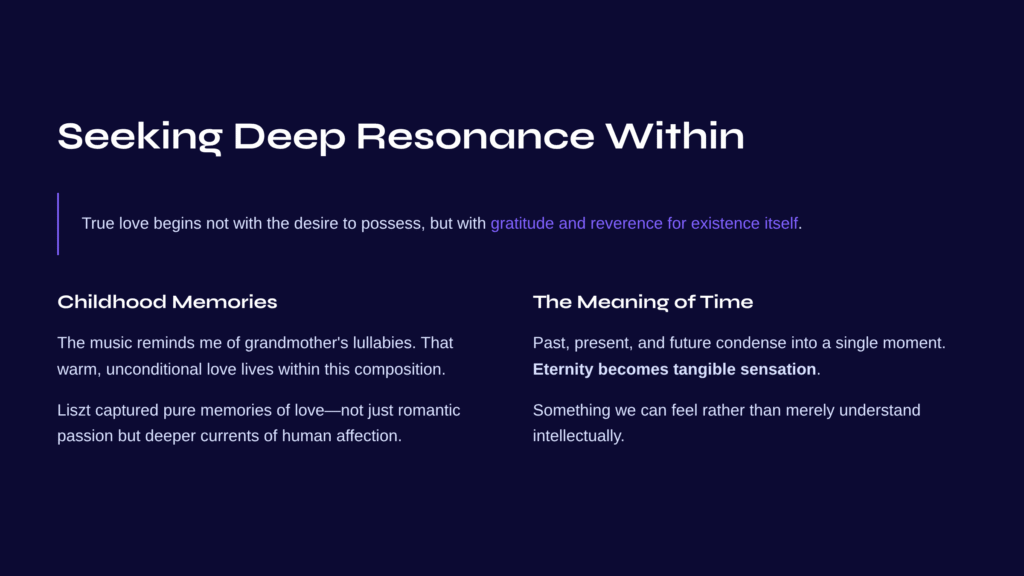
Seeking Deep Resonance Within
Listening to this music, I often contemplate the nature of love itself. Where do the great and small emotions we experience daily ultimately originate? Liszt’s Liebestraum No.1 seems to offer one answer: true love begins not with the desire to possess, but with gratitude and reverence for existence itself.
While listening, I’m reminded of my grandmother’s lullabies from childhood—that warm, unconditional love seems to live within this music. Perhaps Liszt wanted to express such pure memories of love through his composition, to capture not just romantic passion but the deeper currents of human affection that flow beneath all our experiences.
This piece also makes me consider the meaning of time. As the music unfolds, we experience past, present, and future condensing into a single moment. Eternity becomes not an abstract philosophical concept but a tangible sensation—something we can actually feel rather than merely understand intellectually.
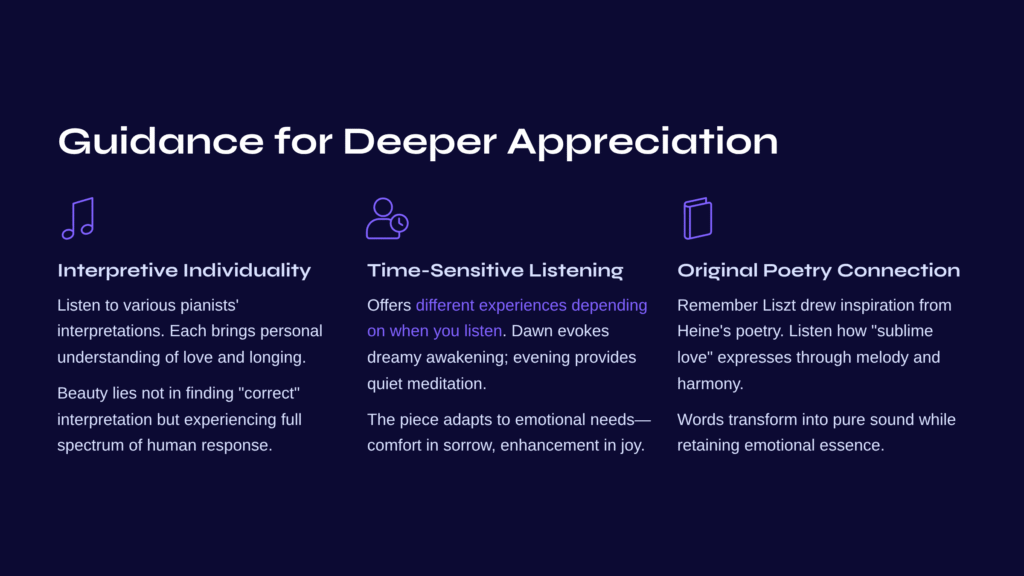
Guidance for Deeper Appreciation
Focusing on Interpretive Individuality
To appreciate Liebestraum No.1 more deeply, I recommend listening to various pianists’ interpretations. Comparing how different performers approach this piece reveals fascinating insights. Some take a more lyrical approach, others more dramatic. Discover which interpretation resonates most deeply with your own heart.
Each great pianist brings something personal to this music—their own understanding of love, their own relationship with longing and fulfillment. The beauty lies not in finding the “correct” interpretation but in experiencing the full spectrum of human response to Liszt’s creation.
The Art of Time-Sensitive Listening
This piece offers completely different experiences depending on when you listen. Heard at dawn, it evokes the dreamy atmosphere of awakening from sleep; in the evening, it provides quiet meditation to close the day. Try listening at various times to create your own special moments with the music.
I’ve found that this piece seems to adapt to our emotional needs—offering comfort in sorrow, enhancing joy in happiness, providing companionship in solitude. It’s as if Liszt composed not just notes but a faithful friend.
Appreciating with Original Poetry
Remembering that Liszt drew inspiration from Heine’s poetry, knowing the meaning of the original text deepens the musical experience. Listen carefully to how the theme of “sublime love” is expressed through melody and harmony, how words transform into pure sound while retaining their emotional essence.
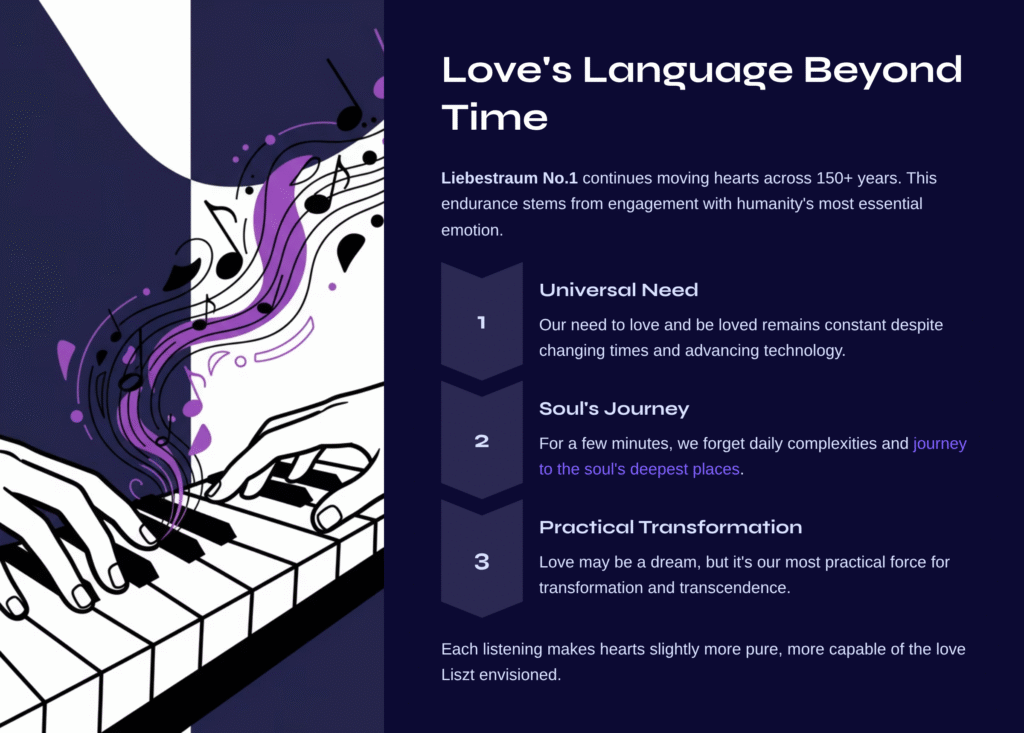
Love’s Language Beyond Time
Liszt’s Liebestraum No.1 continues to move hearts across more than 150 years. This endurance stems from its engagement with humanity’s most essential emotion: the yearning for pure love. Despite changing times and advancing technology, some things remain constant—our need to love and be loved, our attraction to beauty, our longing for the eternal.
Each time I hear this piece, I’m newly amazed by music’s magical power. For a few minutes of performance time, we can forget daily complexities and journey to the soul’s deepest places. Returning from that journey, we discover hearts made slightly more pure, slightly more capable of the love Liszt envisioned.
Ultimately, love’s dream doesn’t end in dreaming. Through that dream, we gain strength to create better reality. Perhaps this was the message Liszt wanted to embed in his music: love may be a dream, but it’s simultaneously our most practical force for transformation and transcendence.
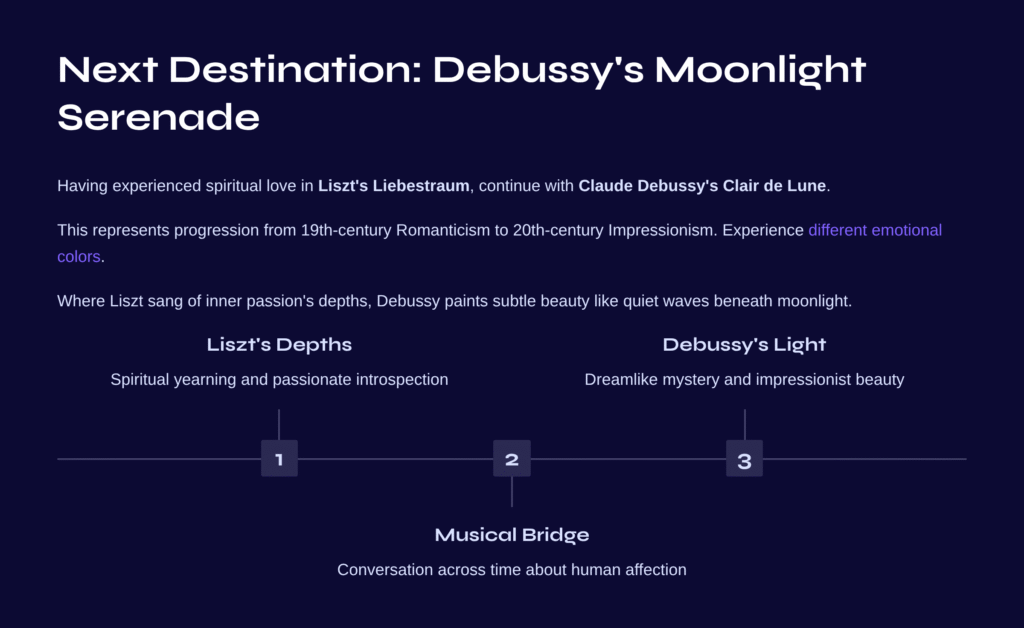
Next Destination: Debussy’s Moonlight Serenade
Having experienced the depths of spiritual love in Liszt’s Liebestraum, why not continue the journey with Claude Debussy’s Clair de Lune? This represents not only a historical progression from 19th-century Romanticism to 20th-century Impressionism, but more importantly, an opportunity to experience different emotional colors.
Where Liszt sang of inner passion’s depths, Debussy paints subtle beauty like quiet waves beneath moonlight. Though both are piano works, you’ll encounter completely different worlds. Inspired by Verlaine’s poetry, this piece will invite you on a new journey of appreciation through its dreamlike and mysterious atmosphere.
Listening to both pieces in sequence reveals how variously love can manifest, and how composers from different eras expressed this universal emotion in their unique musical languages. Together, they form a conversation across time about the many faces of human affection and longing.
